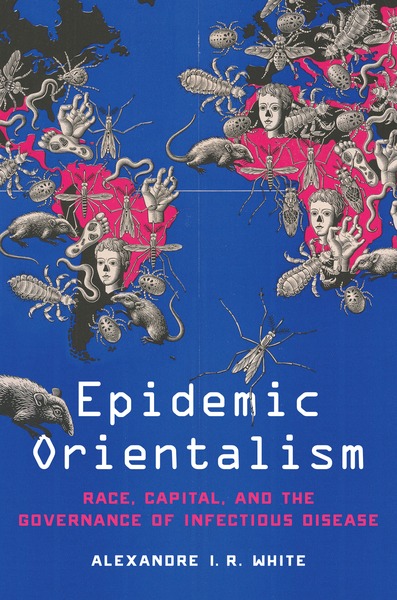Reviewed Book
Epidemic Orientalism: Race, Capital, and the Governance of Infectious Disease By Alexandre I.R. White, Palo Alto, CA: Stanford University Press. 2023. 304 pp.

Agustín Fuentes
Princeton University
The global dynamic of COVID-19, whether you see it as ongoing or having gone on, should minimally force scholars to consider more deeply the geopolitical processes and structures engaging infectious disease outbreaks. In Epidemic Orientalism: Race, Capital, and the Governance of Infectious Disease Sociologist and Historian of Medicine Alexandre White persuasively and effectively pushes such enquiries towards the recognition of the “fundamental relationship between Western Modernity and colonialism” as a central feature in the ongoing and historical processes that impact the global spread of disease. White argues that this relationship produces an Epidemic Orientalism, a dominant discursive frame in global infectious disease control that motivated the rise of international infectious disease regulation almost two centuries ago and has persisted and morphed via the “ideologies of Western and European exceptionalism, colonialism and radical capitalism.” Modifying Edward Said’s Orientalism in this manner, White offers a guiding framework and theoretical template to narrate and interpret the history of international infectious disease regulation weaving connections between and offering understandings of past epidemics, our most recent pandemic, and those to come.
Opening with a lengthy quote from Mary Wollstonecraft Shelley’s The Last Man (1826) sets the stage and tone. In that book Shelley tells of a global plague that wipes out humanity in 2094. It starts somewhere in the colonial south, creeping its way across the globe, virulent and untreatable, until it ultimately reaches Britain. This geographic directionality of disease and the casting of the “south” as the source of illness, and the locus of danger to the “civilized” world, White argues became the global political framing for the next 2 centuries (through today). This was of course not due to Shelley, but rather to what White describes as Epidemic Orientalism, the suite of events and landscapes wherein epidemiolocal and medical knowledge were and are mapped, analyzed and deployed primarily within a framework that assumes a division of “the West from the rest.”
To lead the reader thought his argument, White relies on an extremely detailed and largely chronological historical account beginning with the history behind and emergence of the International Sanitary Conventions in the 19th century, moving to the creation and rise of the World Health Organization (WHO), and then a series of case studies. Throughout these historical and contemporary examples, diverse sets of data and details of disease outbreaks and myriad responses, White deploys a range of sociological and anthropological theory and perspectives to move beyond the details of the historical record and into the theorization and explication needed to make such a grand, and information dense, narrative sensical and relevant.
This book is packed with well cited information (40 pages of notes for 252 pages of text). It offers those deeply interested in the minutia of the International Sanitary Conventions, their relation to the WHO, and the geopolitical dynamics creating of and created by the two organizations a wealth of detail. The book also lays out, clearly, the pattern and procedures of the current Public Health Emergency of International Concern (PHEIC) process and reviews the times this has been invoked and the dynamics behind it and outcomes from it. This connection to the contemporary mode of epidemiological global action is critical as it enables a nuanced molding of the key frame (Epidemic Orientalism) to the current moment in ways that retain the rich theoretical framework but also allow for the shifting geopolitical landscapes. And, as one might expect, the engagement with the COVID-19 pandemic is well considered and while important does not dominate or obscure the larger narrative. The final chapter before the conclusion, “Pricing Pandemics,” fascinatingly and importantly links together the frame of Epidemic Orientalism and Necrofinance.
The conclusion is heartfelt and effective, a fine capstone to a strong text. Here one finds the summary of White’s argument: that international infectious disease control must be understood through attempts to regulate disease spread as they intersect with, and are structured by, “concerns for trade and travel, capitalist expansion, and colonial systems of relations, organized around a perspective that the lives that are most needing of saving are those in the wealthy Western World.” To my surprise, in reflecting on the arc of the book White suggests that there was more that could be included, such as greater detail of colonial medical practices. As a reader I can agree that such information would be interesting but disagree that such information was a necessary component of this specific scholarly journey. The book is information-packed, well structured, and the arguments need no additional bolstering. In the end, Alexandre White makes clear his hope that the text provides the material to recognize the specific infectious disease-related histories, perceptions, and ideologies undergirding the “West vs. the rest” frame. And in that vein White offers a parting caution: yes, regulatory or medical preparations are important in the face of global infectious disease outbreaks but challenging and changing Epidemic Orientalism as a frame of being/acting/structuring is at the core of developing more effective navigation, and amelioration, of future pandemics.